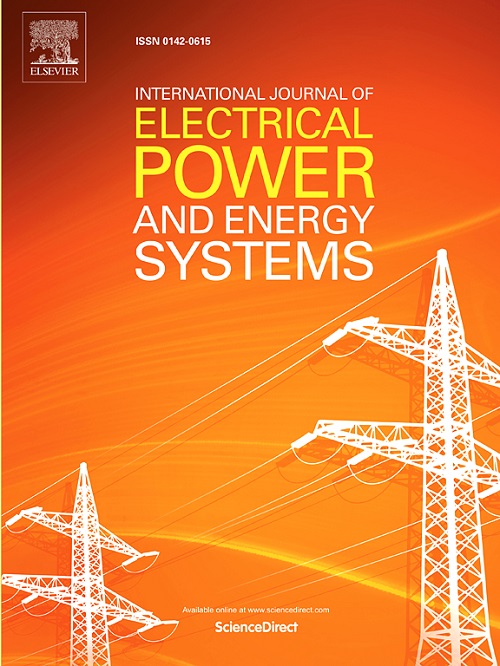考虑机械暂态模型的dfig -蓄热系统最优频率调节RMPC策略
IF 5
2区 工程技术
Q1 ENGINEERING, ELECTRICAL & ELECTRONIC
International Journal of Electrical Power & Energy Systems
Pub Date : 2025-09-20
DOI:10.1016/j.ijepes.2025.111101
引用次数: 0
摘要
与传统方法相比,集成dfig -蓄热系统在频率调节、风力发电集成、能源效率和减排方面表现出优越的性能。然而,风速的固有可变性和不可预测的负载扰动给系统组件之间的频率调节功率优化分配带来了重大挑战。为了解决这些挑战,本研究提出了一种基于鲁棒模型预测控制(RMPC)的频率调节策略,该策略同时考虑了源侧和负载侧的干扰。首先,建立了dfig -蓄热系统参与一次调频的响应模型。该模型考虑了风力涡轮机的机械和电磁特性,以及组件运行限制和功率平衡等各种约束条件。其次,针对风速的不确定性和随机负载干扰,引入基于RMPC的方法对频率调节模型进行修正。此外,利用强对偶理论将最小-最大双层鲁棒优化模型简化为单层形式。采用前向差分法改进了构件响应模型的离散化,使策略的求解成为可能。最后,在MATLAB/Simulink中对该方法进行了实例验证。结果表明,该方法在保持有效频率调节的同时,降低了8.8%的运行成本。本文章由计算机程序翻译,如有差异,请以英文原文为准。
RMPC strategy for optimal frequency regulation in DFIG-thermal-storage systems with a mechanical transient model consideration
The integrated DFIG-Thermal-Storage system demonstrates superior performance in frequency regulation, wind power integration, energy efficiency, and emission reduction compared to conventional approaches. However, the inherent variability of wind speed and unpredictable load disturbances create significant challenges in optimally allocating frequency regulation power among system components. To address these challenges, this study proposes a robust model predictive control (RMPC)-based frequency regulation strategy that simultaneously accounts for both source-side and load-side disturbances. Firstly, a response model is developed for the DFIG-Thermal-Storage system participating in primary frequency regulation. This model considers the mechanical and electromagnetic characteristics of wind turbines, as well as various constraints such as component operation limits and power balance. Next, to address the uncertainty of wind speed and random load disturbances, the RMPC based method is introduced to modify the frequency regulation model. Furthermore, the strong duality theory is utilized to simplify the min–max double-layer robust optimization model into a single-layer form. The discretization of the component response model is improved using the forward difference method, enabling the solution of the strategy. Lastly, the proposed method is evaluated through several examples in MATLAB/Simulink. The results show that the proposed method reduces operational costs by 8.8% while maintaining effective frequency regulation.
求助全文
通过发布文献求助,成功后即可免费获取论文全文。
去求助
来源期刊
CiteScore
12.10
自引率
17.30%
发文量
1022
审稿时长
51 days
期刊介绍:
The journal covers theoretical developments in electrical power and energy systems and their applications. The coverage embraces: generation and network planning; reliability; long and short term operation; expert systems; neural networks; object oriented systems; system control centres; database and information systems; stock and parameter estimation; system security and adequacy; network theory, modelling and computation; small and large system dynamics; dynamic model identification; on-line control including load and switching control; protection; distribution systems; energy economics; impact of non-conventional systems; and man-machine interfaces.
As well as original research papers, the journal publishes short contributions, book reviews and conference reports. All papers are peer-reviewed by at least two referees.

 求助内容:
求助内容: 应助结果提醒方式:
应助结果提醒方式:


